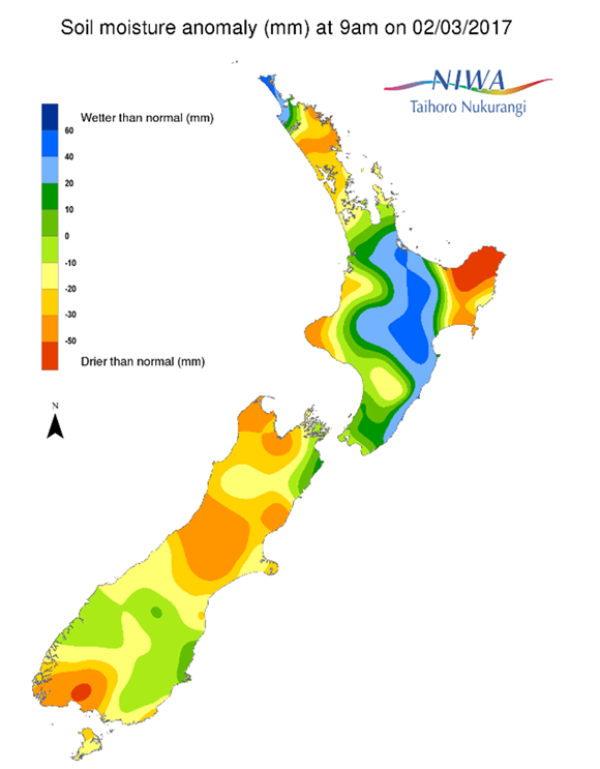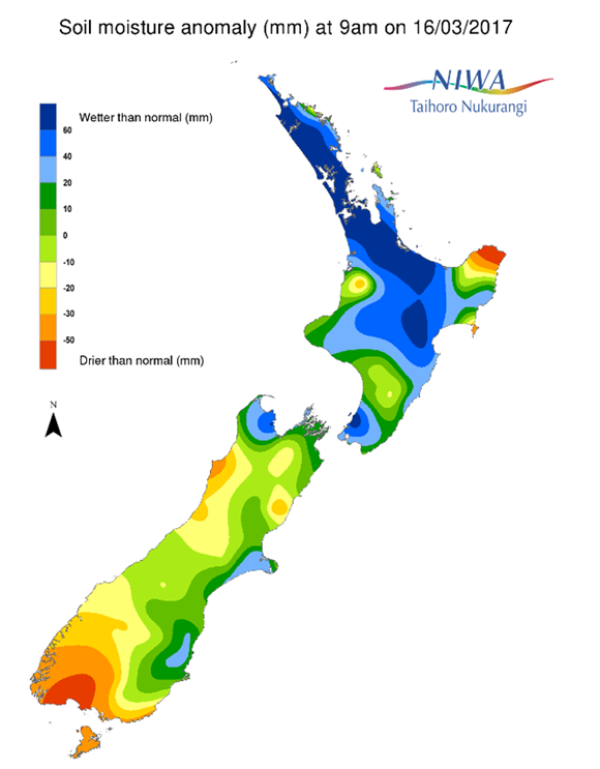A weekly update describing soil moisture across the country to help assess whether severely to extremely dry conditions are occurring or imminent.
Regions experiencing these soil moisture deficits are deemed “hotspots”. Persistent hotspot regions have the potential to develop into drought.
Facts: soil moisture
Across the North Island, soil moisture levels have remained the same or increased since the last report issued in early March. Soils are wetter than normal for this time of the year for much of the island from Northland to Hawke’s Bay, as well as from Wellington to the Kapiti Coast. All other areas have soil moisture that is near normal for this time of year. Presently, there are no hotspots on the North Island.
Note: on the map dated 16 March, the dryness indicated near East Cape and Te Kuiti is a result of erroneous rain data. Consequently, these areas are not experiencing drier than normal soils for this time of year.
Across the South Island, with the exception of southwestern Southland, soil moisture levels have remained the same or increased since earlier this month. The most significant increase in soil moisture was observed across the east of the island from about Dunedin to Christchurch. The driest soils across the South Island compared to normal for this time of the year are found in southwestern Southland, where the dryness has expanded northward somewhat to near the West Coast region.
Currently, a small hotspot is located in the Hurunui District, with a larger hotspot located near and west of Invercargill.
Outlook and soil moisture
Across the North Island, high pressure will generally dominate for the next several days. Weakening cold fronts from the southwest may produce scattered, light rainfall this weekend, chiefly over eastern parts of the island. There may be a chance for more widespread showers next Thursday evening over the lower part of the island. Over the next seven days, it’s likely that most locations on the island will receive less than 10 mm of rain, and for many places, less than 5 mm of rainfall.
Consequently, soil moisture levels will decrease over the next week. However, since most of the island has soil moisture levels that are unusually moist for this time of the year, no hotspot development is expected. However it is quite possible soils will become drier than normal for this time of year over the lower part of the island, in and around Palmerston North.
For the South Island, the combination of cold frontal passages early and late in the period along with an onshore west wind will mean episodes of rain, particularly along the west coastal region south of Greymouth, where rainfall totals of 25-75+ mm are likely by this time next week. Weekly amounts of 10-25 mm are possible from near Dunedin to east of Fiordland. For the remainder of the island, rainfall over the next seven days will be light and total less than 25 mm north of Greymouth and less than 10 mm elsewhere.
As a result, soil moisture levels will hold steady or increase for most areas along and west of the Divide, including southwest Southland. All other regions will likely experience a decrease in soil moisture by this time next week. Hotspot areas in southwest Southland will likely stop expanding, if not contract while the hotspot in the Hurunui is likely to grow.
Background:
Hotspot Watch: a weekly advisory service for New Zealand media. It provides soil moisture and precipitation measurements around the country to help assess whether extremely dry conditions are imminent.
Soil moisture deficit: the amount of water needed to bring the soil moisture content back to field capacity, which is the maximum amount of water the soil can hold.
Soil moisture anomaly: the difference between the historical normal soil moisture deficit (or surplus) for a given time of year and actual soil moisture deficits.
Definitions: “Extremely” and “severely” dry soils are based on a combination of the current soil moisture status and the difference from normal soil moisture (see soil moisture maps).


